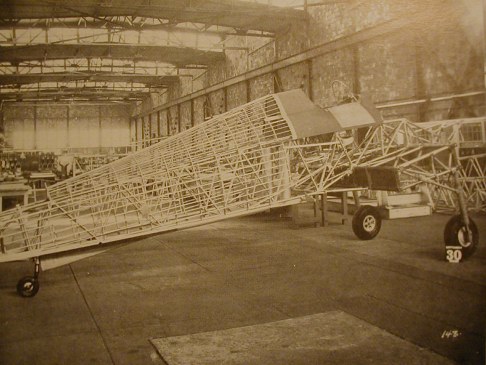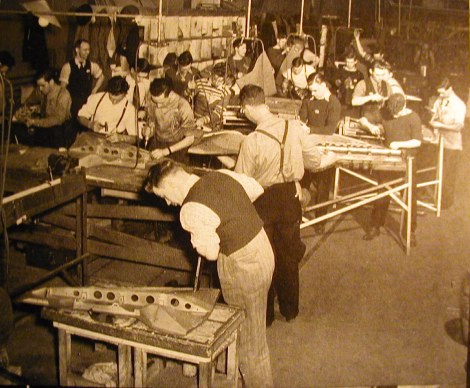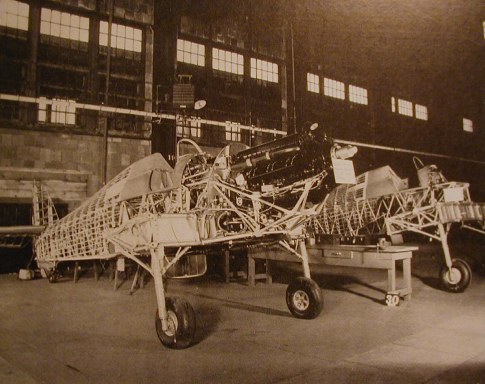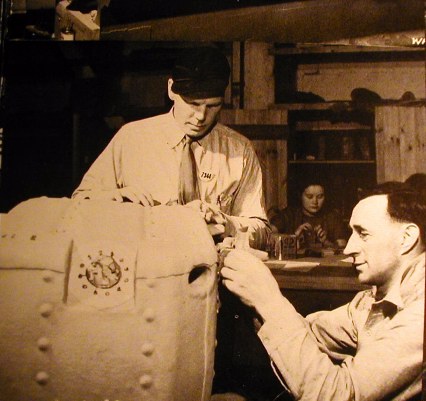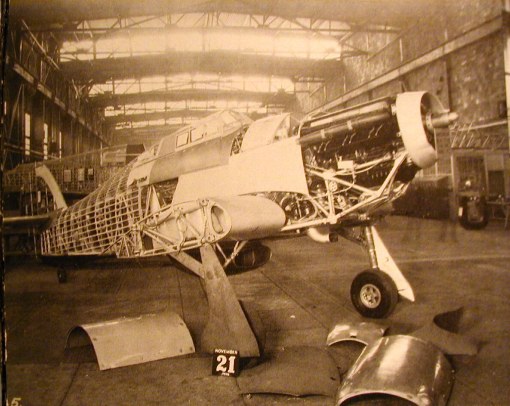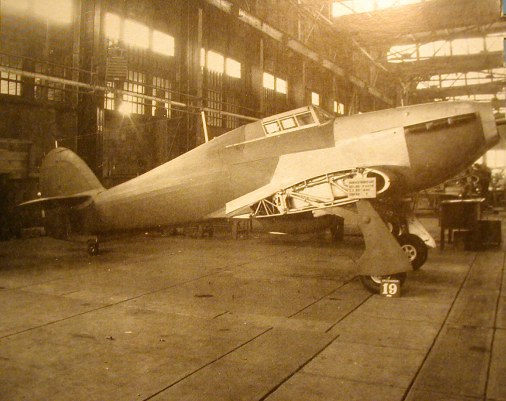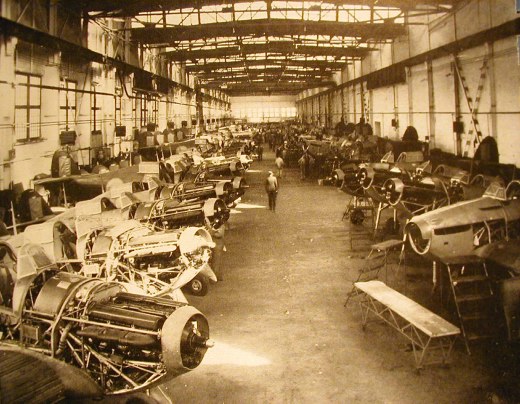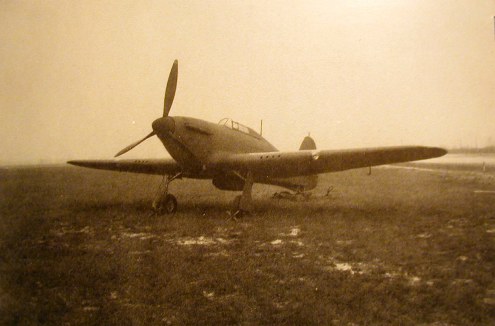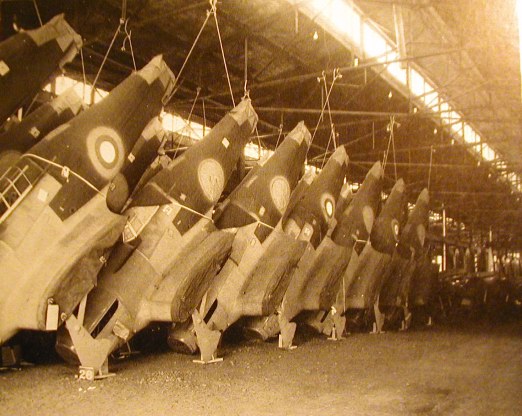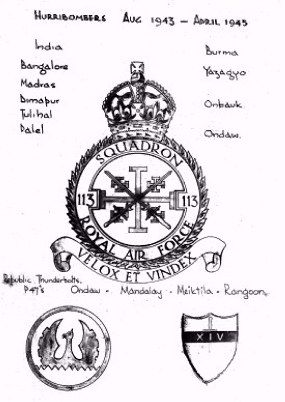HAWKER
HURRICANE
1941 Company Poster Advertisement.
The caption reads: In the mid - west, remote from costal vulnerability, the Fort William plant of the company sends forth the Hurricane in quantities never before attempted in the Canadian aircraft industry. All of this aircraft is built within the environs of the company; an acomplishment of which Canada should be justifiably proud.
Designed and built by the Hawker Aircraft Ltd. in England, a total of 12,780 Hurricanes were built, 10,030 by Hawker and 2,750 by subcontract to Gloster Aircraft Co. Ltd. Counting the 1,451 built in Canada by the Canadian Car and Foundry Co. there was a total of 14,231 Hurricanes built during the war.
A winning design from the start, in june 1936 production got underway with an order of 600 which was soon increased to 1000. The first production Hurricane Mk1 (L1547) took flight on the 12th October. Some of the numerous modifications made to the Hurricane included self-sealing fuel tanks, tropicalization which included the distinctive Vokes filter below the nose for desert work, and the addition of two 45 or 90 gallon under-wing tanks. The early production models had fabric-covered wings which was changed to metal-covered wings in the later models. The first Squadrons to recieve Hurricanes was No. 111 Squadron at Northolt in December 1937 followed a little later by No. 3 Squadron at Kenley. Following the outbreak of hostilities, the Hurricane was fitted out to Nos. 1, 73, 85 and 87 Squadrons in France to form an advanced striking force. The Mk.II made its first flight on 11 June 1940 and in August 1940 the RAF took delivery of its first Mk.IIAs. The Mk.IIB carried twelve .303 calibre Browning machine guns while the Mk.IIC carried four 20 mm cannon, either Oerlikons or B.S.A. Hispanos. In June 1941 the Mk.IID carrying two 40 mm Vickers cannon was supplied to the Western Desert forces as a "tank buster" version. The Hurricanes were also converted to fighter-bombers called "Hurribombers"and were modified by the Royal Navy to become "Sea Hurricanes". By September 1943 the Hurricane was sporting rocket projectiles. The Mk.IV made its debut on 14 March 1943 and was the last production version of the Hurricane. The MkIV aside from being fitted with more armour, had what was called a Universal armament wing which could mount either "two 40 mm cannon" or "eight rocket-projectiles" or "two 500 LB bombs" or "long-range tanks".
The Hurricanes produced in Canada, excepting an initial batch of standard Mk. Is, all had U.S. Packard-built Merlin engines in place of the Merlins used in England and were designated Mks. X through XIIA. For further info on Canadian built Hurricanes and serial numbers see: http://www.rcaf.com/aircraft/feature/hurricane/hurricane.shtml
An approximate breakdown of shipments is as follows:
Belgium (20), Canada (868), Egypt (20), Finland (12), India (300), Ireland (12), Persia (now Iran) (29), Poland (1), Portugal (40), Rumania (12), South Africa (50), Tukey (29), Yugoslavia (24), Russia (2,952*) *many were not received by Russia due to heavy losses of the sea convoys.
RANGE: 135 Miles
HURRICANE PRODUCTION IN THE COLONIES
It is little known that while Britain continued to send fighter pilots out like lambs to the slaughter in long obsolete biplanes to face Germanys best, and indeed continued to build these obsolete types, Canada was poised and willing to throw all effort into aircraft production. As early as 1936 as the skies of war loomed dark, a delegation approached the Brittish government with a plan to help build the sorely needed aircraft in Canada. On return home the delegation reported that Ministry Officials in London were "tolerantly amused" by the suggestion that first line military aircraft could be built in Canada. Britain's other great colony of Australia did not have any production facilities at the time but you can be sure that they would have instantly rose to the challange requiring very little money or effort from Britain to become a valuable alternative source of production. In fact, if only half the effort to keep the colonies out of production was spent helping them set up, it is a virtual certainty that Britain could have entered the war on a far greater parity with Germany. As it was, the United States who at that time had no intention of getting involved in the war, and would not be forced into it for half a decade yet, took Canada up on it's offer. Despite this, Canada continued to hound the Brittish but to no avail. It was obvious that the mother country had no intention of letting any part of their own aircraft production escape to the colonies.
When you read the numerous stories and biographies of the months leading up to war and how Britain was so desparately vulnerable and unprepared, it is hard to imagine that secretly behind the scenes ministry officials were turning away help. Granted, it was a tough sell to even get the production rolling at home, given their cumbersome pre war procurment system and extensive meddling by those who would stand to gain financially from the rapid buildup of war materials. In any event the war came as most knew it would, and as the Brittish newspapers tossed blame back and forth on Britains unpreparedness, the great aircraft production capabilities of Canada collected dust. The blame for this falls squarely on those charged with British production and not once, but on a dozen occasions Canada was told that not only was "Canada's help" not needed, but what ever the "Canadian" aircraft needs were, "Britain would look after them". It was a ridiculous assertion that bordered on madness considering Britains peril. The old boys who controlled the Ministry of Aircraft production would bring Britain a breath away from defeat before Churchill would step in briefly and bust up this club of influential upper crust industrialists.
Nonetheless, for whatever reason, Canada persisted and only after Hitler had steamrolled over half of Europe did Britain finally hand out an "educational" order for 40 Hurricanes to be completed by December 1940. 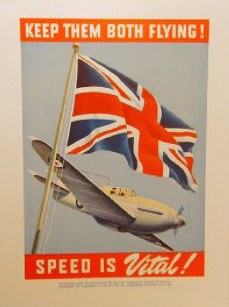 It should come as no surprise that this "not so co-incidentally" occured about the time the Ministry of Aircraft Production got it's long overdue shakeup and the then Minister, Air Marshall Sir Wilfred Freeman was pushed aside in favour of Churchills good friend and "Canadian" newspaper baron, Lord Beaverbrook. Beaverbrook with his roots in British politics and his empire in Canada would have been well aware of the nonsense going on and it is safe to say that through him, so did Churchill. Beaverbrook was of course tasked to make up for this lost production by urgently producing as many fighter aircraft as he could. An easy task considering the massive production capabilities his predecessor left sitting idle in the colonies. Before he sat down at his new job, Canada was building fighters!
It should come as no surprise that this "not so co-incidentally" occured about the time the Ministry of Aircraft Production got it's long overdue shakeup and the then Minister, Air Marshall Sir Wilfred Freeman was pushed aside in favour of Churchills good friend and "Canadian" newspaper baron, Lord Beaverbrook. Beaverbrook with his roots in British politics and his empire in Canada would have been well aware of the nonsense going on and it is safe to say that through him, so did Churchill. Beaverbrook was of course tasked to make up for this lost production by urgently producing as many fighter aircraft as he could. An easy task considering the massive production capabilities his predecessor left sitting idle in the colonies. Before he sat down at his new job, Canada was building fighters!
Why this first small Hurricane order was deemed "educational" can easily be guessed but rather than being offended, Canada Car Company (of Canadian railroad fame) tooled up for the job, built facilities then built the aircraft and sent them off to Britain 5 months ahead of schedule. This no doubt gave cause for a smile from Beaverbrook and made those "who insisted on an educational order first" look like fools. More orders for Hurricanes immediately followed. 120 more at first, then 400, then 600, then 1000 untill scarcely three months after they were to have completed their educational order of 40, the plant was instead churning out 25 new Hurricanes "a week" as well as spares, gun wings, catapults, etc. On the face of it, it was an incredible stunt which bordered on impossible and leads one to believe that Beaverbrooks appointment was simply the last step in a master plan. In other words, the arrangements had long been made, Churchill dropped Beaverbrook in to flip the switch on. Indeed, aside from kicking a few butts, it was about all he did before he moved on to become Minister of State. Sadly however, his empty chair was still warm when the old boys, back in control, immediately chopped production in Canada of these desparately needed fighter aircraft nearly in half to15 a week. All the while they were telling their desparate Generals in the Middle East and the Balkans that they were doing their best and could spare few planes. "This moment" April 1941 that they cut production, the RAF had all but been wiped out in Greece, bombers were being picked from the skys by the score because of the lack of fighters, thousands would soon die and many brave ships evacuating troops would be mercilessly attacked and sunk because of the lack of fighter aircraft.
It is no coincidence whatsoever that Britain took no Canadian aircraft and the bulk that were exported were used for the dangerous 'high loss' shipments to Russia. As a consequence many of these desparately needed Hurricanes were lost before they even saw service.
In the end a good percentage of Canadian aircraft production went to the Americans, and fitting out Canada's own aircraft crews. As the war progressed Canadian production greatly increased in support of its motherland but at no time did it come anywhere near being fully utilized. The upper crust of British industrialists and others that intimidated, exerted influence or otherwise interfered because they had a vested financial interest in producing as much of the war material as possible, should have been held fully accountable following the war and tried by the courts. Their selfish contemptable manipulation in order to profit from the war, cost many young brave men's lives and in this authors opinion are no better than the Nazis. It is neither far fetched or unreasonable to say that had Britain used it's great colonies like Canada, Australia and others to the fullest, the course of the war would have been vastly different.
HURRICANE SITUATION PRIOR TO FALL OF BURMA - 1942
The following is an excerpt of a report by Air-Vice-Marshal D. F. Stevenson regarding air operations in Burma to General Sir Archibald P. Wavell at General Headquarters, New Delhi, India on the 28th September, 1942.
On the 20th January ABDA Command (00186 of 20/1) informed the Air Ministry that while the reinforcements asked for were undoubtedly required, it was not known whether they would have to be found from the aircraft allotted to the South Pacific theatre. The full position was asked before agreement to allocate from the total pool was possible since the need in the Southern Malayan theatre was more immediate than that in Burma.
(While the Air Ministry stalled with the ridiculous request for more paper work to assess "the full position" the entire British forces were being driven out of Burma and by March 6th 1942, "barely six weeks later" the Japanese had taken the country.)
27. Proposals for immediate Fighter reinforcement.
On the 2nd February the Deputy Chief of the Air Staff telegraphed the Air Ministry's proposals for reinforcements for Burma in the immediate future (Webber iW.446 of 2/2). This approved an immediate reinforcement of 2 further Hurricane Squadrons, bringing the programme to 6 Hurricane Squadrons in all, but assumed that we should be able to re-equip 67 Squadron,with Hurricanes. There were never enough Hurricanes to do that. After the fall of Singapore on February 15th the Chiefs of Staff diverted these 2 Squadrons (30 and 261 Fighter Squadrons) to Ceylon. Thus the total Fighter force actually available throughout the air campaign in Burma was
reduced to 3 Hurricane Squadrons.
28. Initial Equipment of Hurricane Squadrons and the Hurricane Flow.
The inability adequately to equip our Squadrons with Hurricanes and to maintain them during air action had a serious effect on the air campaign. For example, it led to a situation in which it was only possible for 6 Hurricane II's to take the air against the first heavy attack on our air base at Magwe on 21st March and except for 1 aircraft every Hurricane II in the 'Command was present at Magwe on that day.
29. The requirement initially to equip 17,135 and 136 and to re-equip 67 Squadron was a total of 80 Hurricanes i.e. 16 (I.E.) plus 4 (I.R.) per Squadron. Additionally, a flow of at least 24 per month was necessary to meet minimum war wastage.- Therefore over the campaign which lasted three months, the total requirement was at least 128. During this period a considerable number of our Hurricanes due for Burma were diverted to Singapore. Thus of this total requirement only a proportion arrived in Burma and of these a number were obsolescent, worn-out Hurricane I's.
30. Hurricane Effort
Consequently the maximum number of Hurricanes reached in action with the enemy was about 30 Hurricanes, i.e. the equivalent of 2 instead of 4 Squadrons. This strength, moreover, fell away rapidly due to lack of reinforcing aircraft, proper operational facilities and absence of spares, and was on the 11th February, 15 serviceable Hurricanes, and on the 5th of March only 6.
THE EVOLUTION OF A HURRICANE
The following rare pictures give a glimpse into the evolution of a Hurricane in production at the manufacturing facilities of Canadian Car Corp, Aircraft Division located in Fort William Canada.
The fuselage of the Hurricane being assembled
The Hurricane oleo leg is assembled.
Engines and landing gear are fitted to the Hurricane's.
The famous puncture proof Canadian Hurricane gas tank, the envy of the Japanese.
Cowling and fairing parts are installed.
A Hurricane ready for wings.
Note the terrible rear and downward views from the cockpit of the Hurricane, it would be impossible to see an attacker coming in from below or the rear. It would be interesting to know what the pilots thought of this.
A birds eye view of the assembly line.
Ready to fly. In this case, the first Canadian built Hurricane took to the sky on January 9th, 1940
Ready for Shipment.
Precious few made it to the Middle East or anywhere for that matter. Sadly the politics and meddling would purposely see to it that very few of these aircraft would ever get to the areas where they were desparately needed. Partly to keep them off British soil, most were used for high risk overseas shipments and sit on the bottom of the ocean packed in the holds of ships just as you see them above.
All of the above pictures were taken at the Canada Car Company, Aircraft Division. Source K Crawford
Hand drawen Squadron crest with the Hurricane
theaters of operation listed
Copyright: F/Sgt Gerard Brigden
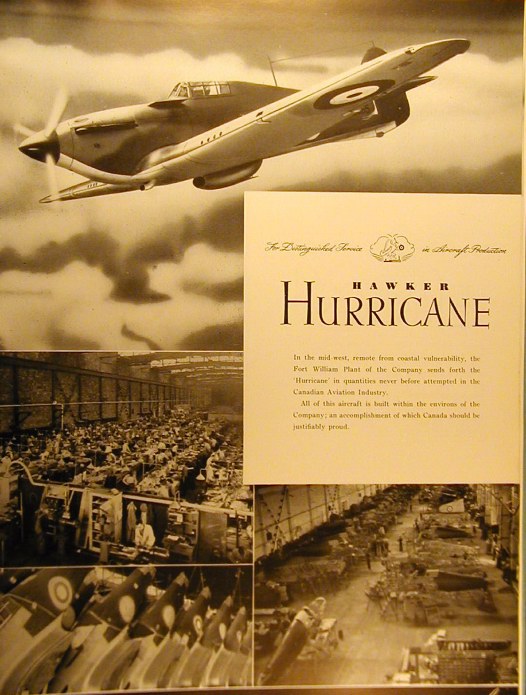

 It should come as no surprise that this "not so co-incidentally" occured about the time the Ministry of Aircraft Production got it's long overdue shakeup and the then Minister, Air Marshall Sir Wilfred Freeman was pushed aside in favour of Churchills good friend and "Canadian" newspaper baron, Lord Beaverbrook. Beaverbrook with his roots in British politics and his empire in Canada would have been well aware of the nonsense going on and it is safe to say that through him, so did Churchill. Beaverbrook was of course tasked to make up for this lost production by urgently producing as many fighter aircraft as he could. An easy task considering the massive production capabilities his predecessor left sitting idle in the colonies. Before he sat down at his new job, Canada was building fighters!
It should come as no surprise that this "not so co-incidentally" occured about the time the Ministry of Aircraft Production got it's long overdue shakeup and the then Minister, Air Marshall Sir Wilfred Freeman was pushed aside in favour of Churchills good friend and "Canadian" newspaper baron, Lord Beaverbrook. Beaverbrook with his roots in British politics and his empire in Canada would have been well aware of the nonsense going on and it is safe to say that through him, so did Churchill. Beaverbrook was of course tasked to make up for this lost production by urgently producing as many fighter aircraft as he could. An easy task considering the massive production capabilities his predecessor left sitting idle in the colonies. Before he sat down at his new job, Canada was building fighters!